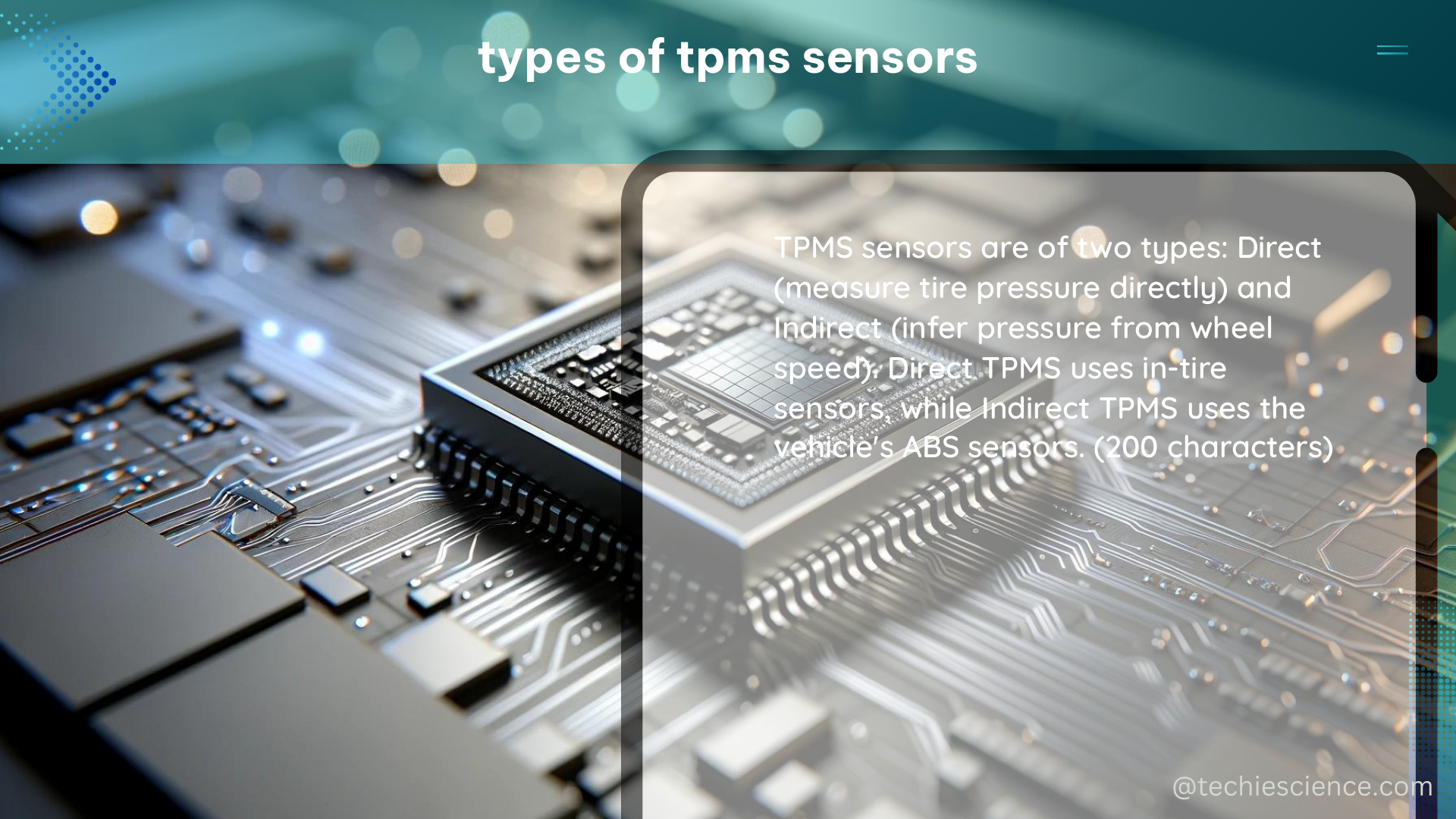Tire Pressure Monitoring Systems (TPMS) are an essential safety feature in modern vehicles, designed to alert drivers when tire pressure falls below a certain threshold. There are two main types of TPMS sensors: direct and indirect. This comprehensive guide will delve into the technical details, cost considerations, and installation/maintenance aspects of each type, providing you with a thorough understanding of the different TPMS sensor options available.
Direct TPMS Sensors
Direct TPMS sensors are located within each tire and measure the tire pressure directly. These sensors can be further categorized based on their mounting location:
Internal Tire-Mounted Sensors
- These sensors are installed inside the tire, typically on the wheel rim or the tire valve stem.
- They offer better protection against external damage and theft, as they are housed within the tire.
- According to a study by TNO, internal tire-mounted sensors can cost around €5 per wheel.
- The TPMS chip, which can contribute more than 50% to the overall cost, is the most expensive component of these sensors.
- These sensors typically measure tire pressure in kPa or psi and temperature in Celsius or Fahrenheit, transmitting the data to the vehicle’s on-board computer via radio frequency (RF) signals.
- Installation and maintenance of internal tire-mounted sensors may require specialized tools and expertise, particularly for battery changes and sensor replacement.
External Valve-Mounted Sensors
- These sensors are mounted on the tire valve stem, outside the tire.
- They are less expensive than internal tire-mounted sensors, with a cost of around €25 per wheel, according to the TNO study.
- External valve-mounted sensors are more susceptible to damage due to their exposed location.
- Like internal tire-mounted sensors, they measure tire pressure and temperature, transmitting the data via RF signals.
- DIY installation and maintenance of external valve-mounted sensors are generally easier due to their accessibility.
Rim-Mounted Sensors
- Rim-mounted sensors are less common and are typically used in high-performance vehicles.
- These sensors are installed on the wheel rim, either inside or outside the tire.
- Rim-mounted sensors offer a balance between the protection of internal tire-mounted sensors and the accessibility of external valve-mounted sensors.
- The cost of rim-mounted sensors can vary depending on the specific design and integration with the vehicle.
- These sensors also measure tire pressure and temperature, transmitting the data via RF signals.
- Installation and maintenance of rim-mounted sensors may require specialized tools and expertise, similar to internal tire-mounted sensors.
Indirect TPMS Sensors

Indirect TPMS sensors, on the other hand, do not measure tire pressure directly. Instead, they use the vehicle’s anti-lock braking system (ABS) to monitor wheel speed and infer tire pressure based on the differences in wheel rotation.
- Indirect TPMS sensors are generally less accurate and reliable than direct TPMS sensors, as they rely on indirect measurements.
- However, indirect TPMS sensors are typically less expensive to implement, as they do not require individual sensors in each tire.
- The installation and maintenance of indirect TPMS systems are generally simpler, as they do not involve the installation of individual sensors in each tire.
- Indirect TPMS sensors do not provide the same level of detailed tire pressure and temperature data as direct TPMS sensors.
Factors to Consider when Choosing TPMS Sensors
When selecting TPMS sensors for your vehicle, there are several factors to consider:
- Accuracy and Reliability: Direct TPMS sensors offer more accurate and reliable tire pressure monitoring compared to indirect TPMS sensors.
- Cost: Direct TPMS sensors, especially internal tire-mounted and rim-mounted variants, tend to be more expensive than external valve-mounted and indirect TPMS sensors.
- Maintenance and Installation: External valve-mounted sensors are generally easier to install and maintain, while internal tire-mounted and rim-mounted sensors may require more specialized tools and expertise.
- Vehicle Compatibility: Ensure that the TPMS sensors you choose are compatible with your vehicle’s make, model, and year.
- Regulatory Requirements: In many countries, the use of TPMS is mandated by law, so it’s essential to comply with the relevant regulations.
By understanding the technical details, cost considerations, and installation/maintenance aspects of each TPMS sensor type, you can make an informed decision that best suits your vehicle’s needs and your budget.
References
- Evaluation of the Effectiveness Of TPMS in Proper Tire Pressure Maintenance, Fueleconomy.gov, https://www.fueleconomy.gov/feg/pdfs/811681.pdf
- Study on Tyre Pressure Monitoring Systems (TPMS) as a means to reduce CO2 emissions and improve road safety, TNO, https://climate.ec.europa.eu/document/download/a72c3926-a097-4272-8bb6-8bb4f200dcb8_en?filename=tno_2013_final_report_en.pdf
- Final Rule: Federal Motor Vehicle Safety Standards; Tire Pressure Monitoring Systems; Controls and Displays, NHTSA, https://www.nhtsa.gov/document/final-rule-federal-motor-vehicle-safety-standards-tire-pressure-monitoring-systems-0

The lambdageeks.com Core SME Team is a group of experienced subject matter experts from diverse scientific and technical fields including Physics, Chemistry, Technology,Electronics & Electrical Engineering, Automotive, Mechanical Engineering. Our team collaborates to create high-quality, well-researched articles on a wide range of science and technology topics for the lambdageeks.com website.
All Our Senior SME are having more than 7 Years of experience in the respective fields . They are either Working Industry Professionals or assocaited With different Universities. Refer Our Authors Page to get to know About our Core SMEs.